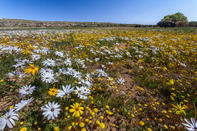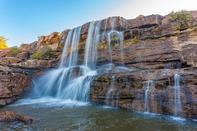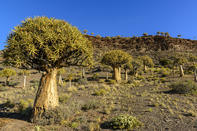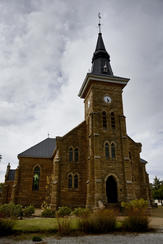Wild Flowers
It is the position and view of Nieuwoudtville that makes the little Northern Cape dorp so utterly spectacular. It sidles on the edge of the Bokkeveld Plateau, in between grey phyllites, quartzites, red sandstones and shales and looks out towards the vast Atlantic, where the Namaqualand dunes nibble at the waves.

In the spring, the earth's browns and ochres dissolve into wild greens, pinks, yellows and reds when the Namaqualand flowers do their thing. The Nieuwoudtville Wildflower Reserve and Hantam National Botanical Garden just outside Nieuwoudtville offer some of the finest displays in the Cape.
Nieuwoudtville Falls

During the summer months you wouldn't see much water, but between May and October, after the rains, the Nieuwoudtville Falls are a sight. Take the R 357 out of Nieuwoudtville towards Loeriesfontein and, five kilometres down the road, pull over at a simple sign noting a waterfall.
Walk a short way into the veld down the path and the sight that greets you is completely unexpected: the gentle little Doring River suddenly plummets through a sandstone crack and then silks over a 100 m high sandstone amphitheatre into a canyon that extends for 10 km into the Bo-Karoo, rather than over the escarpment edge, as you'd expect.
Gannabos Kokerboom Forest

Visit the Kokerboom Forest on Brandkop Farm north of town and the dazzling fields of colour on Matjiesfontein Farm south of town on the gravel road which links up with the R364 to Clanwilliam.
Kokerbooms are succulents, rather than trees as we know them, but they are so distinctive and emblematic of the dry, western parts of South Africa that they might well have been nominated our national tree instead of the more obvious yellowwood.
It was Simon van der Stel who coined the name kokerboom ('quiver tree') when, on an expedition deep into Namaqualand, he noticed that the San used the trees' soft, hollowed-out branches as quivers for their short, poisoned arrows, In fact, from a distance, they appear more like jagged, crudely cut metal sculptures than anything growing naturally.
There are seven species of quiver tree, of which the most common is Aloe dichotoma. The yellow winter blooms are laden with nectar and are a welcome feast for birds and bees. Gannabos, 25 km north of Nieuwoudtville, is claimed to be the largest and the most southerly quiver tree forest in the world (that would include Namibia). Having something like 3800 quiver-tree aloes.
Nieuwoudtville Buildings

When it came to building the new cable-station facilities on top of Table Mountain, stonemasons were brought in from Nieuwoudtville because that's the last place, apparently, where you can still find practitioners of this ancient craft.
The village has many fine old dressed-stone buildings, tallest among which is, naturally, the church. Many of the buildings in the district are more than 200 years old. Go north from the village up the R357 and you'll find the Loeriesfontein windmill display - a rather apt exhibit for this great dry region.
By David Bristow